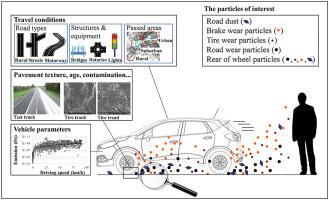Atmospheric Pollution Research ( IF 4.5 ) Pub Date : 2020-12-23 , DOI: 10.1016/j.apr.2020.12.014 A. Beji , K. Deboudt , S. Khardi , B. Muresan , L. Lumière

|
The purpose of this study is to identify the parameters governing particle emissions at the rear of the front wheel of an instrumented light-duty vehicle. The information obtained from the road is complemented by data acquired on a test track. By comparing the signals recorded at various locations around the vehicle, a distinction can be drawn between rear of the wheel particles (RoWP) and particles resulting from tire and road wear (TRWP). Both types of emissions are highly dependent on driving speed. TRWP mainly fall in the size ranges of <0.03 μm and 0.05–0.30 μm by their number, and 0.1–0.6 μm and 1.0–15 μm by mass when using a mean density of 2.0 g/cm3. Within these ranges, TRWP account on average for 40% and 25% of RoWP emissions, respectively. We also evaluate herein the influence of: i) pavement contamination by particulate matter, ii) road geometry, iii) driving area, and iv) structural elements affecting road traffic. Test track experiments finally provide information on the significance of accelerations, decelerations, pavement texture and age. This knowledge compilation may be implemented in future non-exhaust particulate emissions standards; moreover, it establishes a basis for realistically assessing emission dynamics and identifying affected areas.
中文翻译:

使用公路和试验轨道实验确定轻型车辆的轮后和轮胎路面磨损颗粒排放量的因素
这项研究的目的是确定控制轻型车辆前轮后部颗粒排放的参数。从道路获得的信息将得到在测试轨道上获得的数据的补充。通过比较记录在车辆周围各个位置的信号,可以区分出车轮后部颗粒(RoWP)和轮胎和道路磨损导致的颗粒(TRWP)。两种排放都高度依赖于行驶速度。当使用2.0 g / cm 3的平均密度时,TRWP的尺寸范围主要在数量上<0.03μm和0.05–0.30μm,在质量范围0.1–0.6μm和1.0–15μm。。在这些范围内,TRWP分别平均占RoWP排放量的40%和25%。我们在此还评估以下因素的影响:i)颗粒物对路面的污染,ii)道路几何形状,iii)行驶区域,以及iv)影响道路交通的结构要素。测试轨道实验最终提供了有关加速度,减速度,路面纹理和年龄的重要性的信息。该知识汇编可在未来的非排放颗粒物排放标准中实施;此外,它为实际评估排放动态并确定受影响区域奠定了基础。



























 京公网安备 11010802027423号
京公网安备 11010802027423号